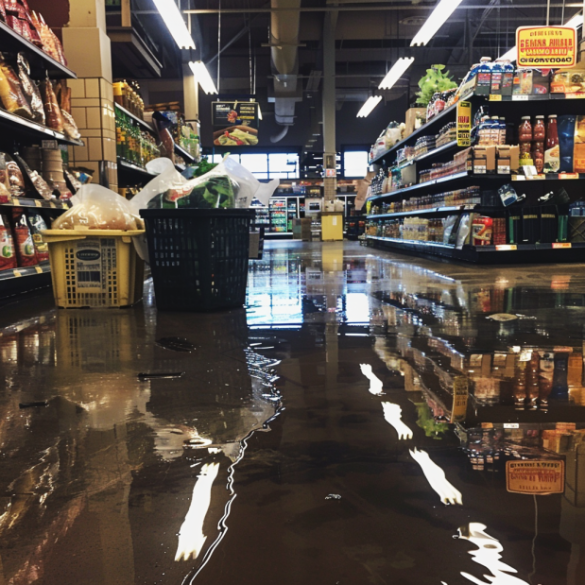If you were injured in a slip and fall accident on someone else’s property in Oklahoma City, you may be able to file a premises liability claim against the property owner (or the business) to seek compensation for your damages. However, slip and fall defendants have several potential defenses they can raise to try to avoid or limit their liability in these cases.
Comparative Negligence
One of the most common defenses in Oklahoma slip and fall cases is comparative negligence. Under this doctrine, the property owner argues that the injured person was partially or fully responsible for causing the accident through their own negligence.
The property owner may claim that:
- The hazard was “open and obvious,” and the victim failed to notice it because they were distracted.
The most common example would be someone walking through a puddle and nearly knocking over the “wet floor” sign before falling. Or someone is texting while walking and trips over the wet floor sign.
- The victim was wearing improper footwear for the conditions
The plaintiff is wearing old, cheap (the $1 kind) flip-flops where the tread has completely worn off. It’s raining, so the sandals are wet, and the plaintiff slips when walking into the store.
- The victim ignored warning signs about the hazard
It’s surprising how often this happens. Someone sees a “wet floor” sign and decides to go ahead and walk through the wet floor.
- The victim was walking where customers are not permitted, like the closed-off area of a kitchen restaurant.
If the victim is found to be partially at fault, their damages award will be reduced by their assigned percentage of fault. If they are 50% or more at fault, they are barred from receiving any compensation under Oklahoma’s modified comparative negligence rule. In such cases, it becomes crucial for individuals to seek legal advice to navigate the complexities of their situation. An experienced Oklahoma City premises liability attorney can help victims understand their rights and potential compensation based on the specifics of their case. They can also provide guidance on gathering evidence to prove the other party’s negligence, which is essential for maximizing any potential damages awarded.
According to Okla. Stat. tit. 23 § 13 and Okla. Stat. tit. 23 § 14, if the plaintiff’s negligence is found to be of a greater degree than the defendant’s, or if it is greater than the combined negligence of all defendants, it can bar recovery. Otherwise, the plaintiff’s recovery is reduced in proportion to their contributory negligence.
Lack of Notice
Another defense property owners may raise is that they lack actual or constructive notice of the hazardous condition. To be liable, the owner must have known or “reasonably should have known” about the danger and failed to fix it or warn visitors in a timely manner.
There isn’t a clear rule on a time requirement for how long the hazard existed before the accident. The owner may argue that:
- The hazard arose very close in time to the accident, not allowing sufficient time to discover and address it
- The hazard was not discoverable upon reasonable inspection
- Regular maintenance and inspection procedures were followed
The most common example is at a restaurant buffet. A customer spills a drink, and another customer slips and falls right after the spill.
Oklahoma case law provides further insight into this defense
- Lingerfelt v. Winn-Dixie Texas, Inc. established that a storekeeper may be held liable for a dangerous condition created by the storekeeper or an employee if it existed for a sufficient time for the storekeeper or employee to have had actual or constructive knowledge thereof and to have it removed in the exercise of ordinary care.
- Rogers v. Hennessee emphasized that an invitor cannot be held responsible unless it is shown that they had notice or could be charged with gaining knowledge of the condition in time sufficient to effect its removal or to give warning of its presence.
- Town of Okemah v. Lindsey reinforced the principle that the existence of actual notice, or facts constructively equivalent to actual notice, as well as the reasonable sufficiency of measures taken to prevent injury from an unsafe condition, are ordinarily questions for the jury to determine.
Open and Obvious Doctrine
The “open and obvious” doctrine is related to comparative negligence. It provides that a property owner has no duty to warn or protect visitors from hazards that are open and obvious to a reasonable person.
Examples may include a visible spill, like a red Gatorade on a white grocery store floor or a large pothole in a parking lot. The rationale is that the visitor should have seen and avoided the obvious hazard through reasonable care.
However, there are exceptions, such as when the owner should anticipate that visitors may be distracted and fail to protect themselves against an obvious danger. The specific facts of each case must be carefully analyzed. This is a question for the jury.
Oklahoma case law sheds further light on this doctrine
- In McClendon v. McCall, the court held that even where an open and obvious condition injures an invitee, a landowner may still have a duty to warn of or otherwise protect the invitee from the dangerous condition if the injury was reasonably foreseeable to the landowner.
- The court in Shank v. Whiting-Turner Contracting Co. noted that even where an open and obvious condition injures an invitee, a landowner may still have a duty to warn of or otherwise protect the invitee from the dangerous condition if the injury suffered was reasonably foreseeable to the landowner.
Recreational Use Statute
Oklahoma’s Recreational Use Statute provides immunity to landowners who open their property for recreational use by the public free of charge. Common examples include parks, hiking trails, lakes, and campgrounds.
Under Okla. Stat. tit. 76 § 16.1 and Okla. Stat. tit. 76 § 80, qualifying landowners owe no duty of care to keep the premises safe for entry or use by recreational users, or to give warning of a dangerous condition, use, structure, or activity on the premises.
There are exceptions, such as for willful or malicious failure to guard or warn against an ultra-hazardous condition. But in general, this statute provides a defense to many slip and fall claims arising on recreational properties.
Trespasser Liability
If the plaintiff was trespassing at the time of the injury, the property owner may owe no duty of care to keep the premises safe or to warn of dangerous conditions. The exception to this is if the defendant’s conduct that caused injury was willful, wanton, or involved gross negligence. Okla. Stat. tit. 76 § 16.1 and Okla. Stat. tit. 76 § 80. The example we were taught in “Torts 1o1” in law school was that a landowner is not allowed to set a trap for trespassers. If I recall correctly, the defendant in that case had a shotgun loaded with a string!
Frequently Asked Slip and Fall Defenses Questions
Can a property owner be held liable if the dangerous condition is open and obvious?
Yes, even if the dangerous condition was open and obvious, a property owner may still be held liable if the injury suffered was reasonably foreseeable to the landowner. In general, the question of whether or not a condition is open and obvious is up to the jury, too, so this fact question can at least get the case through the “summary judgment” stage.
What happens if the plaintiff was partially at fault for the fall?
If the plaintiff’s negligence is found to be greater than the defendant’s, or if it is greater than the combined negligence of all defendants, it can bar recovery. This is the “50% rule” to barring recovery for the plaintiff.
Who determines whether the property owner had notice of the dangerous condition?
The existence of actual notice, or facts constructively equivalent to actual notice, as well as if reasonable measures were taken to prevent injury from an unsafe condition, are ordinarily questions for the jury to determine. The most common way we should do this is by obtaining the security footage from the store.
Does it matter if there was a warning sign?
Warning signs can impact a slip and fall case. But they must be visible, unobstructed, and located in a place where they can be reasonably seen by visitors approaching from all directions. If a sign is hidden or not visible from the victim’s walking direction, it may not absolve the owner of liability.
What if my accident happened on government property?
Slip and fall accidents on government property have unique rules and shorter deadlines for filing claims. Prompt notice of the claim must usually be filed with the proper government entity. Immunity defenses may also apply to bar specific claims against the government.
How long do I have to file a slip and fall lawsuit in Oklahoma?
The statute of limitations for most slip and fall lawsuits in Oklahoma is two years from the accident date. However, for claims against the government, a notice of the claim must typically be filed within just one year. It’s important to consult with an attorney as soon as possible to preserve your rights and the evidence on the case. In addition to understanding the timeline for filing a lawsuit, it is crucial to be aware of the types of damages in slip and fall incidents. These can include medical expenses, lost wages, and pain and suffering, all of which can significantly impact one’s financial stability. An experienced attorney can help you assess your claim and determine the appropriate compensation for your particular situation.










